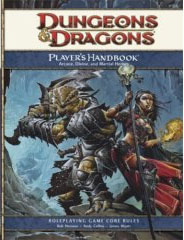 Yesterday I talked about the potential advantages of using dissociated mechanics to achieve certain goals and proffered the example of scene-based resolution mechanics.
Yesterday I talked about the potential advantages of using dissociated mechanics to achieve certain goals and proffered the example of scene-based resolution mechanics.
4th Edition is, apparently, going to offer a scene-based resolution mechanic in the form of skill challenges. Since I like scene-based resolution mechanics, I must be OK with 4th Edition’s skill challenges, right?
Well, not exactly.
(DISCLAIMER: This essay is based entirely around the pre-release details of 4th Edition which have been posted to WotC’s website or otherwise revealed to the public. In the case of the previous examples I’ve discussed in this series, I’m pretty secure in my belief that the aspects of the system I’ve been talking about will still be there in the core rulebooks. However, in the specific case of skill challenges it is certainly possible that some of the problems I discuss here will be resolved by additional details in the core rulebooks. However, based on what I’ve read, I consider that unlikely.)
The important thing to understand is that I’m not just OK with scene-based resolution mechanics for the sake of scene-based resolution mechanics. I like certain scene-based mechanics specifically because they offer greater narrative control to the players (and the benefits that come with that).
(This is actually a fairly general principle: Just because I like a system that involves rolling dice, you shouldn’t conclude that I’m going to instantly love all dice-based mechanics.)
But in the case of 4th Edition’s skill challenge mechanics, it looks like we’re swallowing all the disadvantages of the scene-based mechanic’s dissociation without getting any meaningful benefits from it.
HOW THEY WORK
The core of the skill challenge mechanic in 4th Edition is, essentially, a complex skill check: You have to earn X number of successes before suffering Y number of failures. (For example, in a 4/2 skill challenge you would need to make 4 successful skill checks before failing 2 skill checks in order to succeed at the skill challenge.)
The difference between a skill challenge and a complex skill check, however, is that a skill challenge allows the players to use many different skills. You can read a sample skill challenge at Wizard’s website. In this example the PCs are trying to convince a duke to aid them in their quest, and they can make Bluff, Diplomacy, Insight, and History skill checks in order to earn the 8 successes they need to pass the skill challenge.
THE BASIC DISSOCIATION
The basic dissociation of the skill challenge mechanics lie in their nature as scene-based mechanics. Because they still use skill checks, this can be a little more masked than it was in the case of the Wushu example we looked at before, but the dissociation is still there.
Basically, the skill challenge mechanics don’t care what the PCs are doing — they only care how much the PCs have done. This basic mechanical dissociation manifests itself in several ways:
(1) The skill challenge can report guaranteed failure even though failure has not been guaranteed. This is because it’s quite trivial to imagine skill checks which might help the PCs accomplish a particular task without actually harming their efforts if they fail them. In WotC’s sample, for example, an Insight check will allow the PCs to recognize that using the Intimidate skill will result in an automatic failure.
But what if the PCs fail that Insight check and that results in the failure of the skill challenge? How do you explain that?
You can’t. It would certainly make sense for the failure of that check to potentially lead to failure (if the PCs subsequently attempt to Intimidate the duke) — but if they never do that, then the failure should be irrelevant, not a deal-breaker.
(2) For largely the same reasons, the skill challenge can also report guaranteed success even though success has not been guaranteed.
For example, imagine a skill challenge in which the goal is to get inside a castle. There are several possible solutions the PCs could pursue: They could climb the walls. They could bribe the guards. They could unlock the back door. They could seek to gain an audience with someone inside the castle. They could dig a tunnel under the walls.
The DM decides to define this as a 4/2 challenge.
But now imagine that the PCs spend a good deal of time researching this problem: They make a History check to check up on historical attempts to break into the castle. They make an Architecture check to see if they can find any hidden entrances. They do a Gather Information check to see if they can find any blackmail material on the guards. They do a Diplomacy check to find out who they might be able to get an audience with.
These are all useful skill checks and there’s no good reason why the DM should veto any of them. But if they succeed at all of them, then they’ve achieved their four successes and the skill challenge system is reporting that they’ve succeeded… even though they still aren’t inside the castle.
(3) And, on top of that, the skill challenge mechanics can also fail to report success even though you’ve already done everything required for success.

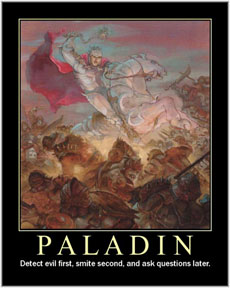
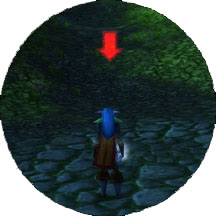

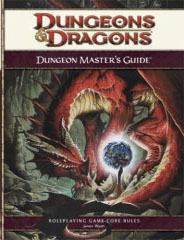
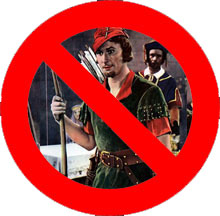 Here’s a sample power taken from one of the pregen characters used in the
Here’s a sample power taken from one of the pregen characters used in the 









